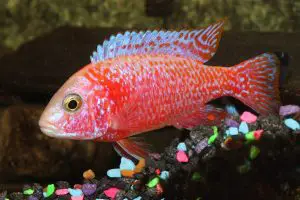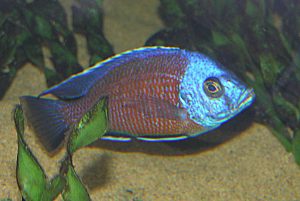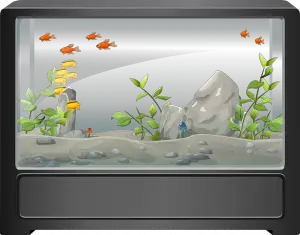Peacock cichlid are amongst the world’s most colorful fish. They are native to Lake Malawi, and are among the Cichlids’ most friendly and peaceful members.
In our full guide to Peacock Cichlids, we will discuss all you need to know, including known varieties, how to care for them, ideal tank mates.
Peacock cichlid is one of the most popular freshwater fish in aquariums in the world. While their mellow nature (for a cichlid) and low-maintenance care plans are certainly a drawback, there is one reason for this that is above the rest:
It’s their beauty.
These fish are absolutely stunning to look at and have colors that you rarely find on the freshwater side of fish farming. We found ourselves in disbelief a number of times when we looked at these fish in person!
But if you want that kind of beauty at home in your tank, you need to understand their specific needs. That’s why we’ve put together this Peacock Cichlid Care Guide.
Species Summary
Consisting of the whole Aulonocara genus of freshwater fish, peacock cichlid, or simply peacocks, are the most friendly and peaceful cichlids you can find in your aquarium.
Peacock cichlids, native to Lake Malawi in East Africa, live near the bottom of warm, deep water where they seek food in the sandy substrate. An active, skilled swimmer, the peacock is always on the lookout for potential prey.
There are over twenty names of peacock cichlids, and it is no wonder that every species is found in Lake Malawi, because this body of water is the ninth largest lake in the world!
However, only a few species are commonly kept in aquariums, including the African butterfly peacock, the flavescent peacock, the sunshine peacock, the Nkhomo-benga peacock, the maulana bicolor peacock, the Aulonocara Fort Maguire cichlid and the Aulonocara blue gold cichlid.
Whatever species you admire, you’ll agree that peacock cichlids are some of the most colorful species of freshwater fish and it’s only fitting that they share their name with a regal bird. Combine their beauty with their relatively docile behavior and you’ll find that adding them to your tank is difficult to resist!
Lifespan
The average lifespan of the peacock cichlid is about six to eight years if proper care is given. This means keeping water parameters, water quality, and diet recommended.
Taxonomy
Here is the scientific classification of peacock cichlid:
| Scientific classification | |
|---|---|
| Kingdom: | Animalia |
| Phylum: | Chordata |
| Class: | Actinopterygii |
| Order: | Cichliformes |
| Family: | Cichlidae |
| Tribe: | Haplochromini |
| Genus: | Aulonocara |
Overview
The Peacock Cichlid is a spectacular fish species native to Lake Malawi; it belongs to the genus Astatotilapia. There are at least 22 different Peacocks species, most of which have stunning colouring.
Their coloring may vary from blues, reds to yellows and in any aquarium it will stand out. The most popular of which is the blue (Aulonocara Nyassae); thus, this article will be the focus.
Most Cichlids are reputed to be aggressive while the Peacock Cichlid is fairly peaceful. Males can be territorial, but overall they are peaceful and can make good fish for the community.
Typical Behaviour
Peacocks are lower dwellers and are to be found at depths of 6 to 40 meters in the wild at Lake Malawi.
Hunting for food among the sand is a common behavior they’ll display. They will hover above the sand and will strike them once they detect any movement from any invertebrate.
This is also a behavior you’ll see when sifting through the substratum in aquariums. They are an active swimmer and one of the quietest Cichlids available.
Appearance
If you’ve seen other Cichlid varieties, you’ll know they ‘re among the most vivid freshwater colored fish in the fishkeeping hobby. Peacock cichlids are no other. They ‘re some of the colorful fish you’ll find, ranging from blue, gold, orange to yellow.
You’ll also notice that their color is in fact iridescent instead of a matt colour. Interestingly their color is permanent, whilst the color of other Cichlids depends on their mood and breeding status.
The different Peacock Cichlid varieties are essentially the same fish with different colours; this color varies depending on the Lake Malawi region from which it originated.
However, it is important to state here that both young and female are typically a drab gray, so if you want to add color to your tank, make sure you buy a male.
Your Peacock should grow to about 6 inches in length and is characterized by an oversized system of lateral lines.
Like other cichlids, peacocks rank among the brightest of all aquarium fish in freshwater. However, unlike their relatives, the color of the peacock cichlid does not depend on their mood or on their matting status.
Colors vary within the species and depend on which area the variety originated from Lake Malawi. Both females and young fish are dull grays in color, but when they mature, males become a stunning shade of iridescent yellow, gold, orange, red, purple, or blue.
You may want to check out these articles:
Apistogramma fish: Complete Guide- 2020
Silver dollar fish: Complete care, Lifespan and breeding- 2020
Peacock cichlid Types
There are currently at least 22 recognized Peacock Cichlid species but not all of them are traded in the aquarium hobby; the most popular are:
- African Peacock Butterfly (Aulonocara jacobfreibergi)
- Aulonocara stuartgranti (Flavescent Peacock)
- Nkhomo Peacock Benga (Aulonocara baenschi)
- Sunshine Peacock (stuartgranti at Aulonocara)
In my experience, red and blue peacocks are the two most common varieties.
Red Peacock Cichlid (Stuartgranti, Aulonocara)

That is actually a Flavescent Peacock variety. It is a creation made by man, and not occurring naturally. It is the same size as other peacocks with the exception of red colour.
You might see them referenced under other names like Ruby Red and Rubin Red when you buy one.
The blue peacock cichlid (Aulonocara nyassae)

A metallic blue, to a bright yellow, and its color will become even more enhanced during the breeding season. As with all other Peacock types, her female counterpart is a gray color.
OB Peacock
Finally, just a word about the Peacock OB. These are hybrids, and crossbreeds between pure breeds of Peacock Cichlids.OB Peacocks are the same size as regular peacocks and provide some unique coloring.
Peacock Cichlid size
You should expect a male Peacock Cichlid in a home aquarium to grow to about 6 inches in length, with females slightly smaller.
Peacock Cichlid Habitat and Tank Requirements

All Peacock Cichlids come from Lake Malawi as mentioned in our general overview section, so your aquarium should closely resemble the conditions found there.
The lake is known to have alkaline water known for its clarity and is extremely stable in terms of its pH and other key parameters.
The Lake area where the Peacocks live is characterized by sandy and rocky areas. So, we recommend that you imitate these conditions inside the tank.
Matching their natural environment will lower your fish’s stress levels and provide them with the optimum conditions they need to stay healthy. Because of this, you should use only hardy plants (think Java Ferns or Anacharis) and make sure to anchor them.
If you plan to keep a community of them then you need a tank of at least 100 gallons. The bigger the tank you’ll have fewer territorial issues.
Also, remember they are active swimmers so it’s preferable to have a horizontal tank here as it gives them more open space to swim in.
One final point about the requirements of habitat and tanks; if you are mixing different varieties of peacocks then make sure that they are adapted to their individual needs. Some prefer more rocky surroundings whereas others prefer sand. That’s why mixing Peacocks requires a larger aquarium so you can adequately provide for their needs.
Fun Fact
Did you know? American Lobsters have longer life spans than both cats and dogs, living over 20 years.
Tank Condition
As for water conditions inside the tank, the water temperature should be kept between 76-82 ° F. PH levels should be kept to 7.8-8.6.
Interestingly, as Lake Malawi is a huge body of water, sudden drops in temperature are not subject to rapid changes in water chemistry. For this reason, make sure the water temperature of your aquarium remains as consistent as possible.
What Tank Size Do Peacock Cichlids Need?
A Peacock Cichlid needs an Aquarium of at least 55 gallons. If you plan to keep a community of them then you will need a 100-gallon tank.
This is because such skilled swimmers and active hunters are those fish. It will give them the space they need to live in the wild like they would.
Obviously a larger tank will also provide enough space to prevent territorial aggression for the multiple caves that are needed. If you maintain a large peacocks community, you may need a tank that holds at least 100 gallons of water to further inhibit their territorial behaviour.
Waters Parameters
Peacock cichlids thrive in a water-based environment that mimics the conditions of their native Lake Malawi, where the temperature is a little warmer than the water habitat of other cichlids.
This body of water is very consistent throughout the year when it comes to parameters and water chemistry. This means that temperature, pH and hardness should be kept as consistent as possible.
- Water temperature: 74°F to 82°F
- pH levels: 7.5 and 8.5
- Water hardness: 4 to 6 dH
It is very important that you keep your water as clean as possible. These cichlids are used for very clear waters in their natural habitat, and their health will suffer if their quality of water is not maintained.
Peacock cichlids Diet and Feeding
Peacock cichlids are omnivores which means they eat meat as well as plant/vegetables.
They are bottom dwellers in the wild meaning they’ll sift for food through the sandy substrates. Insects, larvae, zooplankton and other crustaceans will typically be these.
Inside your aquarium, you should try to emulate that. Start by making a quality cichlid pellet that is the core of your diet; you can then add meat and vegetables to that.
You can use meat to:
- Shrimp Brine (live or frozen)
- Frozen Daphnia
Interestingly, you should avoid tubifex worms and all mammalian meat, as this may cause bloat from Malawi.
However you can feed them with flakes, just make sure they are suitable for cichlids.
In terms of feeding frequency, you should aim to feed them with several smaller portions throughout the day instead of a single large feeding; this helps to keep the water chemistry there.
Cichlids generally get a bad reputation for being aggressive and they deserve that reputation in general.
Luckily though Peacock Cichlids are not like other Cichlids and are the family’s ‘tamer’ members, and generally much more peaceful.
Peacock cichlid Tank mates
You actually have a lot of choices when it comes to choosing peacock cichlid tank mates. These fish are tame members of the cichlid family and will do well with other non-aggressive fish.

The first thing you need to do is to make sure that any fish you want to keep with your peacocks can survive in the same water parameters; that’s why many people choose tank mates who are also Lake Malawi native.
With your Peacocks you can keep lots of the gentler Haps (Haplochromis); for example:
- Copadichromis
- Placidochromis
- Nyassachromis
- Sciaenochromis
Yet not every cichlid of Lake Malawi can be a Peacocks tank mate. We should avoid other more active fish like Petrotilapia, Labeotropheus, Pseudotropheus and Mbuna.
Male peacock cichlids may be slightly territorial, but they should do fine with other fish as long as you give them enough living space and plenty of caves to hide to reduce their territorial behavior.
You should make sure that their tank mates are capable of handling their precise water parameters. This means that the best options are different types of non-aggressive cichlids.
In general, any non-aggressive type of Haplochromis cichlid (like redfin haps) should be a good tank mate for your peacock. If you are unsure, simply compare the recommended water parameters to see if there is an overlap!
Another species that you can try is the botia loach. These fish are often used as suitable tank mates for peacock cichlids due to their temperament and similar water requirements.
Fun fact:
The amazing Spotted Climbing Perch is able to ‘gulp’ oxygen from the air and can crawl over land using its strong pectoral fins in search of water.
Can you keep cichlids of peacock together?
Put it just, yes.
The best way to keep them together is to make sure you keep a ratio between 1 male and 4 females. This will assist in creating schools within the aquarium.
Also, remember that males are territorial so make sure they have enough space; a 100-gallon tank is sufficient for a community of six.
Breeding of Peacock Cichlids
As indicated in the above section on behavior, male peacocks are territorial and tend to be solitary.
So the first thing you need to do when you want to breed Peacocks is to make sure that each male has its own territory to avoid conflict.
Fortunately, though they’re fairly straightforward to breed in a home aquarium like other cichlids. If encouraging, you can raise the temperature of the water to 82 F as spawning usually takes place in warmer water.
Once they have established their territory (typically a cave) the process of courting can start; this is very entertaining to watch.
The male will ‘perform’ at the entrance to his cave, to lure the females into their cave. Typically, this will look like the male making rapid sudden movements and darting to catch her attention.
Once the female joins the male, they go into the cave, and the female lays eggs in the nest. The male fertilizes the eggs and then the female collects the eggs in her mouth; peacocks are brooders in her mouth. She will now remain inside the cave until the fry is ready to hatch.
She will stay inside the cave and incubate them in her mouth for up to 28 days until they have hatched (between 12-50 little peacocks you should expect). The female will generally leave them to her own devices in an aquarium after the fry has hatched.
Peacock cichlid Diseases
Peacock cichlides may be subject to a fatal condition known as Malawi bloat, which is similar to dropsy and results from eating excess meaty foods. Symptoms of this issue include lack of appetite, inflammation of the abdomen, labored breathing, and a tendency to remain at the bottom of the tank.
This disease has to be taken very seriously if you’re the owner of it. Severe cases cause damage to the liver, kidneys and swim bladder, and may even end in death within one to three days.
Bad bladder disease is another issue that can result from a poor diet. This problem is caused by intestinal gas or parasites which infect the swim bladder.
A fish that is experiencing this problem will float at the top of the tank and will not be able to remain near the bottom to search for food. To prevent this disease, avoid feeding too much protein or dried food to your fish and add more fiber, such as vegetables.
In any event, no cichlid species have ever been overfed, as they tend to consume whatever is available. Overweight fish can lose their lovely coloring and even die prematurely.
Fish tuberculosis is another serious disease that can infect cichlids. Highly infectious, the disease can wipe out the entire population of the tanks over a short period of time.
Symptoms of fish TB include lack of appetite, frayed fins, swollen abdomen, and white blotches on the fish ‘s body.
If you think one fish might be infected, immediately remove the other fish to another tank. Use an antibiotic to treat the new tank and either disinfect the old tank or get rid of it completely.
Is Cichlid Peacock Right For Your Aquarium?
The Peacock Cichlid is one of the easiest and quietest cichlids to keep. Their amazing personality and coloring make them a favorite fan.
Remember to create lots of different territories using caves and rocks to prevent aggressive behavior, when preparing their aquarium.
They are ideal for both new and experienced fishkeepers and will add to most tanks a fantastic amount.
Please contact us for feedback and suggestions.


I like this site it’s a master piece! Glad I observed this ohttps://69v.topn google.Blog range